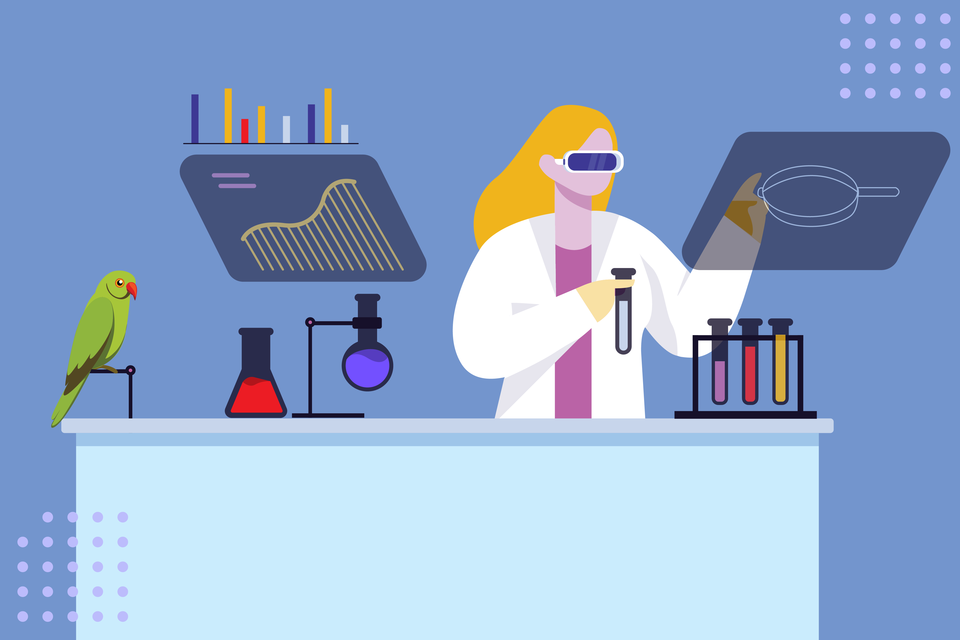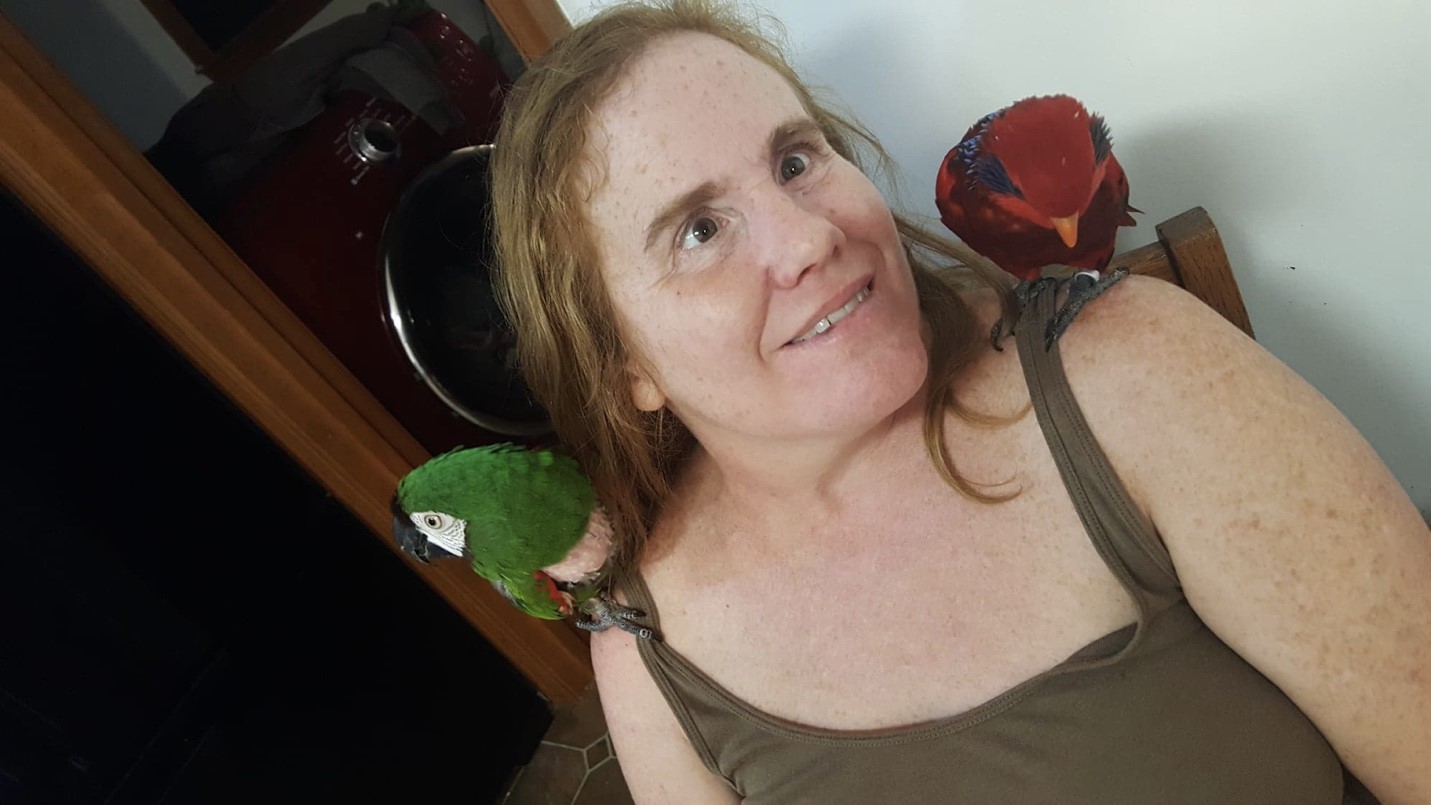Taking Measure
Just a Standard Blog
A Bird’s Eye View: Finding New Ways to Track Synthetic Chemicals in the Environment

I’m not a scientist. I’m not sure if that admission will turn the editorial overlords at the National Institute of Standards and Technology (NIST) against me, but I think it’s important to understand my background before I begin my story. I failed high school chemistry spectacularly, and before last year, I had never stepped foot in a lab. My undergraduate policy degree, a major in foreign affairs and a minor in global sustainability, did not require a single science prerequisite. If you had asked me two years ago what a polyfluorinated compound was, my response probably would have been: “Fluoride? You mean the stuff in toothpaste?”
I did not have what you would call a “science brain.” I did, however, have two parrots.
Parrots and PFAS
Their names were Ned and Mimi, and my parents adopted them when I was 4. They were my honorary siblings. My mother, who is legally blind, absolutely adored them. A couple of years ago she put a pot of water on the stove to boil for pasta but forgot the pot entirely and couldn’t see that she had not put any water in it. She left it on the stove for about a half an hour, on high. This particular pot happened to be equipped with the nonstick coating PTFE, one of a class of chemicals called PFAS (per- and polyfluorinated alkyl substances).
Within that 30 minutes, the parrots began squawking horribly and appeared to be gasping for air. They couldn’t stand, and they eventually fell unconscious. They both passed away less than an hour after my mom put the pot on the stove.
After researching their symptoms, we learned that their deaths were caused by PTFE toxicosis. At 280 C (536 F), the nonstick coating begins to break down, emitting a poisonous chemical fume full of particles and noxious gases. These products are especially toxic to birds because of their unique anatomy. Their deaths made me realize there was an urgent need for more public awareness of the issue. If this chemical could kill birds in a matter of minutes when vaporized, what long-term effects could there be on my mother, who also inhaled those fumes? My childhood pets had become the proverbial canaries in the coal mine.

This devastating event happened just months before I began my graduate education at Georgetown University a little over a year ago. I decided to pursue a degree in environmental metrology and policy, initially intending to form a better understanding of the science underlying environmental legislation. I hoped such a degree would better my chances of eventually landing a policy career in the public sector. My first semester elucidated a number of hot-button environmental issues — including the emerging science and public concern surrounding PFAS. I instantly made the connection. I called my mother immediately after our discussion on these “forever chemicals” and promised her: “Mom, I’m going to avenge our birds.”
And so began my evolution from an overachieving policy student to a full-on chemistry enthusiast.
Finding ‘forever chemicals’
PFAS are a family of over 4,000 synthetic compounds. They are designed to be highly resilient — meaning they don’t break down in the environment. This is why people call them “forever chemicals.” They are used in a vast array of consumer products, from waterproof clothing to cosmetics to food packaging, and, of course, nonstick pans. Over the past 20 years, scientists have determined that certain PFAS compounds pose a significant threat to human health. They have been shown to cause endocrine disruption, birth and developmental defects, cardiovascular degeneration, liver damage and cancer. Because of their commercial prevalence and structural fortitude, these chemicals can be found accumulating in groundwater, oceans, soil and people’s bodies all over the world. They have been found as far as the Arctic Circle, in seals and polar bears. In a study conducted by the Centers for Disease Control and Prevention (CDC), PFAS were found in the blood of nearly every person tested.
These chemicals are a clear risk to environmental and public health at a magnitude I couldn’t have imagined when I began my research. What’s worse, as I quickly learned, is that there is no quick fix. Congress and the EPA are beginning to take action to reduce the prevalence of these potentially harmful chemicals, but what is the best way to introduce policy on something that is present in so many consumer goods?
It’s difficult to lay a blanket regulation over an entire class of chemicals when so many people reap the benefits of them on a daily basis. You’d be surprised how much the inconvenience of scraping scrambled eggs off a dirty frying pan outweighs the laundry list of possible health concerns associated with a nonstick coating. So, the more reasonable solution would be to regulate only the individual chemicals that have been scientifically proven to cause harm. Simple enough — until you realize you must now conduct studies on thousands of chemically different compounds. And that’s where it gets even trickier.
When you test for a harmful substance — say, lead in drinking water — you need to have some way to prove that what you found in that water sample is actually lead. That’s where a reference material comes in. Reference materials contain a known concentration of your target substance (what you are testing for) that you can compare to your sample and say, for certain, that what you are observing is definitely lead. This is called “targeted analysis.” Once you are certain that you have found lead in drinking water, you can make informed policy to regulate and mitigate the problem.
There are currently only a handful of reference materials available for PFAS chemicals. Obtaining more is a difficult task because each compound is the patented property of the chemical company that created it. Therefore, conducting targeted analysis on every PFAS in existence simply isn’t in the cards. I recognized the need for another scientific method to observe the presence of these chemicals in our daily lives if we are to guard against the risk they pose. That’s where my research with NIST came in.
Targeting PFAS with non-targeted analysis
Through my program at Georgetown, a joint venture with NIST and the EPA, I have been lucky enough to intern with Ben Place, a NIST chemist and self-described certified nerd about PFAS. His primary focus is improving the scientific process of non-targeted analysis (NTA), which attempts to identify a substance without the use of a reference material. In order to do so, a sample suspected to contain PFAS is run through an instrument called a mass spectrometer. This instrument is able to provide a unique chemical signature, a “fingerprint,” of the compound it represents.

In targeted analysis, this fingerprint would be compared to the fingerprint of your target reference material. If they match, you have confidence that you know the compound’s identity. In non-targeted analysis, the instrument spits out a full scan — a wide array of spectra, representing nearly every chemical compound present in your sample. In order to filter out the dirt, water and other random impurities, scientists must analyze the spectra using non-targeted methods and deduce which combination of lines may indicate the presence of a PFAS compound.
This process of whittling down a list of suspected PFAS and identifying individual compounds is still very difficult — but not impossible. Once the compounds have been classified with a reasonable level of confidence, scientists using NTA can upload the spectra of a suspected PFAS into a library for other researchers to access. This open availability of PFAS chemical information allows for a wider breadth of research, which will lead to a better understanding of how these chemicals affect the environment and human health. Moreover, the continued innovation and improvement of NTA methods will allow researchers to begin to assign quality controls to them, which will assure a higher level of confidence and reproducibility. The goal is to one day be able to make sound policy decisions about PFAS from NTA data alone, bypassing the need for reference materials altogether.
As I enter the second and final year of my master’s program, I feel equipped with a whole new arsenal of knowledge from my research with NIST. Beyond that, I feel a confidence in my own scientific understanding of PFAS and the chemical world I never imagined I could achieve. My high school chemistry teacher would be proud (and extremely surprised). Although there’s a long road ahead, I hope to contribute to the research that will lead to safe regulations on PFAS in consumer products. Forever chemicals have no place in our environment, our bodies ... or our birds.
I’m not a scientist. But I will be.
About the author
Related Posts
Comments
An important collection of thoughts! I think that "better living through Chemistry" will end up causing a lot of problems in our USA/World!
There are Chlorinated & Fluorinated Hydrocarbons all over in our soil and biology. We are soon approaching a time when most municipal water supplies will be required to start using Reverse-Osmosis to clean up their sources!
DDT has been banned/restricted for ~50 years yet we can still measure it in our human fat tissue.
Thanks!
That is a very good point -- DDT, much like PFAS chemicals, can remain in human fatty tissue for several years, if not longer. Reverse-Osmosis is one of the solutions on the table for extracting PFAS from drinking water, and I very much hope it is implemented.
Thanks so much for reading!
Thank.
Nice read...and inspiring too.. keep moving forward...
Very informative, thank you 😊 keep up the research.
Thank you very much!
What an engaging story!
I learned so much from your article. Thank you for your devotion to this and so well written.
Thank you, Hannah Hidle.
Out with my non stick frying pans.
How do I safely dispose them?
Hi Jim,
Many recycling facilities and scrap yards do not accept nonstick-coated cookware, but some do -- I would suggest checking with your county recycling program to see if they are able to take them off your hands!
Excellent information. You had me at "parrots"!
Sorry to hear about Ned and Mimi's demise but so glad to learn that you’re trying to find a better situation. I’m also glad that you have access to the resources and the opportunity to make a difference. Wishing you much success!
Thank you so much for your kind words!
Very interesting article, wish you a lot of success in your new endeavor.






I learned a lot from reading this. Best wishes for your continued success!